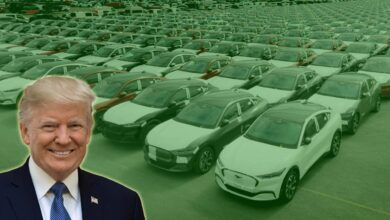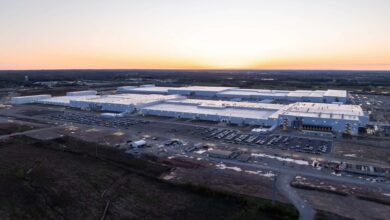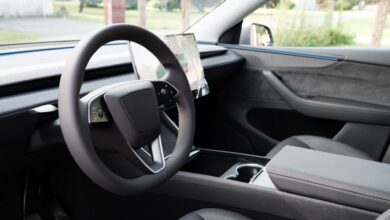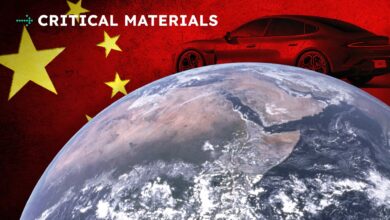We Tried It. It’s A Game-Changer
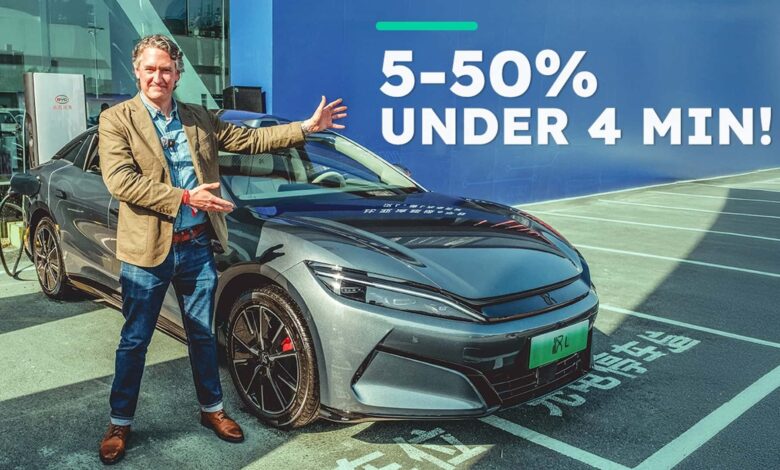
Ask someone who drives a gasoline-powered car why they wouldn’t want to get an electric one, and you’re almost certain to hear this answer: they take way too long to charge.
They’re not even entirely wrong. Even though DC fast charging times are getting shorter and shorter for modern electric vehicles, they can seem totally unacceptable for anyone who’s used to fueling a gas-powered car in a matter of minutes—and that still describes most people in this country.
To counter this, the Chinese carmaking giant BYD, which recently surpassed Tesla in EV sales, came up with an idea so ambitious that it almost sounds impossible. Engineers sought to cut EV fast-charging down to five minutes—roughly what it takes to fill up a gas-powered car.

Photo by: Patrick George
BYD Han L, Tang L and Megawatt Charging
When BYD announced that it had actually pulled this off with some of its latest EVs, the development made headlines all over the world. It’s called Megawatt charging because it delivers 1,000 kilowatts of energy at 1,000 volts, which is twice as powerful as the fastest chargers we have here in the United States. And BYD claims its new electric sedan, the Han L, can gain almost 250 miles (400 kilometers) of range in just five minutes with this setup.
I almost didn’t believe it. So while I was in China for the Shanghai Auto Show, I knew I had to see it for myself. And after a flight to Beijing for a technical briefing and demonstration, to which InsideEVs was the sole Western outlet invited, I can confirm that five-minute fast-charging is very real.

Photo by: Patrick George
BYD Han L, Tang L and Megawatt Charging
Will BYD’s charging breakthrough be on every street corner in a few years, the way gas stations are right now? Not exactly. But BYD has shown the rest of the world what can be done with EV charging. And it’s nothing less than a game-changer for the entire space.
BYD’s Megawatt Charging: What It Is And How It Works
It’s important to understand that BYD’s breakthrough isn’t just a car, or a battery, or the charger itself. It’s all three, and how they work in concert with each other.

Photo by: BYD
It all starts with BYD’s new Super e-Platform. The automaker claims it’s the world’s first mass-produced vehicle platform on a 1,000-volt electrical architecture—higher than the best EVs we have that run on 800 volts, or even the new 926-volt Lucid Gravity. That ultra-high level of voltage, which BYD calls a ”kilovolt architecture,” is what makes these charging speeds possible.
That was no easy task, BYD engineers said. The components to get that done simply didn’t exist, and so BYD had to make them.
That involved self-developed 1,500-volt silicon-carbide power chips, redesigned electric motors and motor controllers, revamped power distribution components and even a reworked heating and air conditioning system. ”From the vehicle’s perspective, a kilovolt architecture means multiple parts need to be designed to handle kilovolt-level power,” a BYD representative told InsideEVs.

Photo by: Patrick George
BYD Han L, Tang L and Megawatt Charging
They said it was an exercise in solving ”multi-physics challenges”—electrical, magnetic, mechanical and thermal—across the entire vehicle from top to bottom to accommodate such unprecedented levels of power.
But like most Chinese automakers, and Tesla, BYD was able to get this done in-house rather than relying on outside suppliers the way Western car companies do. ”The kilovolt architecture represents a comprehensive upgrade of BYD’s EV design system,” the automaker said in a technical briefing. ”With BYD’s vertical industrial layout, a complete kilovolt manufacturing chain has been established independently.”

Photo by: Patrick George
BYD Han L, Tang L and Megawatt Charging
That electrical architecture has yielded incredible performance in other areas. The two cars that use the Super e-Platform, the Han L sedan and Tang L SUV, can both do zero to 60 mph in 2.7 seconds. (After driving the former around Beijing for a bit, I can tell you I believe those claims.) And BYD said it did those launches up to 70 times continuously without any performance degradation, to give you an idea of how robust it is. (By the way, neither car is very expensive; Han L sedan starts at 209,800 yuan, or around $29,000. The Tang L starts at 229,800 yuan ($31,000) and stretches to 289,800 yuan ($40,000).
None of this would be possible without a battery that’s up for the job. But BYD’s Flash Charging Battery was born to do it. The Han L gets an 83.2 kWh battery pack, while the Tang L steps up to 100 kWh. A derivative of BYD’s ”Blade” battery, these are lithium-iron-phosphate (LFP) units, a chemistry that China has essentially mastered these days. LFP batteries offer better longevity and durability than nickel manganese cobalt (NMC) batteries that are more common in the West, albeit with less power density.

Photo by: Patrick George
BYD Han L, Tang L and Megawatt Charging

Photo by: Patrick George
BYD Han L, Tang L and Megawatt Charging

Photo by: Patrick George
BYD Han L, Tang L and Megawatt Charging
Still, the battery required extensively reworked electrolytes, separators and electrodes to reduce internal resistance by a claimed 50%, not to mention the latest version of BYD’s direct refrigerant cooling system. But the result, BYD claims, is something that is both safe and can take this level of fast-charging punishment regularly.
In fact, BYD also claims improvements to the Blade battery mean a 35% increase in its high-temperature lifespan. ”Megawatt charging will not affect the battery,” a BYD spokesperson told me. ”And the warranty policy is the same as the current Blade battery.” (Warranties vary by market.)

Photo by: Patrick George
None of this would be possible without the Megawatt charging station itself. At only five square feet (1.5 square meters) it’s not that large, really. But it does pack incredible power: a maximum output of 1,360 kW. For context, America’s most powerful charging stations are the Gravity fast-chargers in New York City, which can output up to 500 kW. The BYD system also has energy storage built into it, saving up power for fast recharges when the grid isn’t up to snuff—or for deployment in more rural areas.
”The challenge lies in addressing both the vehicle and the 1000 kW charging pile,” a BYD spokesperson said, referring to another term for a charging station. ”It requires a comprehensive kilovolt architecture for the vehicle and solving the entire ecosystem for the charging piles.”
Interestingly, BYD redesigned the plug, or ”gun,” to be better for women and smaller folks to use. It’s the antidote to the bulky CCS fast-chargers we have in America that can often feel heavy and unwieldy for anyone without a good amount of upper-body strength. The gun is only 4.4 pounds, or 2 kilograms, and while it’s not quite as sleek as a Tesla plug, it is definitely easier for me to hold than the average CCS plug I’d find back home.

Photo by: Patrick George
BYD Han L, Tang L and Megawatt Charging

Photo by: Patrick George
BYD Han L, Tang L and Megawatt Charging
So to get the most out of BYD’s system, it’s clear that you need its latest kilovolt-class cars—of which there are only two—and a Megawatt charger as well. Like any DC fast-charger, it will only supply those extreme charging speeds if your EV can take it. But even if you can’t find a Megawatt charger, your Han L or Tang L has an extra surprise should you be able to park between two empty charging stalls.
That’s because BYD’s Super e-Platform cars can take two DC fast-chargers at once. Yes, really.
First Test: BYD’s Dual-Gun Charging System
A few EVs, namely those made by Audi and Porsche, have two charging ports. But one is usually the sole slot for DC fast charging. And no EVs can take two charging sources at the same time.

Photo by: BYD
BYD Blade Battery Dual Charging
That is, unless they have a BYD badge. In order to maximize charging speeds for the times when a full-blown Megawatt charger isn’t around, the Han L and Tang L carry two DC fast-charging plugs, and they can use both at the same time. This setup ”can instantly transform existing supercharging piles into flash charging ones and fast charging piles into supercharging ones,” as BYD puts it.

Photo by: BYD
BYD has used this technology before on cars like the Denza D9 and Denza N7, two vehicles from its luxury brand. But on the Han L and Tang L, dual-gun charging goes to the next level. This latest system can use two 250 kW chargers to deliver speeds of about 500 kW at once. On two 180 kW fast chargers, you’d see speeds of about 360 kW.

Photo by: Patrick George
BYD Han L, Tang L and Megawatt Charging
That was the first order of the day in Beijing. BYD’s crews plugged several Han L and Tang L EVs into two 250 kW stations at the same time. One vehicle I saw started with a 13% state of charge. When plugged into both stations, it started charging at almost 400 kW—more than I had ever seen before with my own eyes—in quick order. I watched it charge to 25% in about a minute.

A Han L sedan with plugs in both ports.
Photo by: Patrick George
That alone would be a monumental achievement for EV charging. But the main event was yet to come.
Second Test: BYD’s Five-Minute Megawatt Charging

Photo by: Patrick George
BYD Han L, Tang L and Megawatt Charging
After a brief jaunt through Beijing afternoon traffic, aided by BYD’s God Eye automated driving assistance system, our convoy arrived at a local dealership to try Megawatt charging. BYD’s demonstration involved one car plugged into the Megawatt station while a projector screen showed the crowd of journalists the charging results.
By the way, contrary to some reports, Megawatt charging does not require the use of two charging guns; that’s just a nice benefit if you’re out and about and can access two fast-charging plugs at once. But to get to speeds of 1,000 kW, you only need one gun and BYD’s special new charger. That was another pleasant surprise on this trip.

Photo by: Patrick George
BYD Han L, Tang L and Megawatt Charging
Once BYD’s staff plugged the car in, it was off to the races.
The Han L sedan used in the test started at 13%. A ”1002 KW” logo flashed across its driver display screen. The car leaped to that speed almost immediately, but then it quickly tapered off to about 767 kW. It got to 30% after just a minute and a half, then 40% after two and a half minutes, where it held steady at 633 kW.

Photo by: Patrick George
BYD Han L, Tang L and Megawatt Charging
About four minutes in, the car was at 50%. In a little under five minutes, the BYD folks called it: 60.10%, while still maintaining a charge speed of 463 kW.
Where it would’ve gone after that, I do not know. But in that short time plugged in, Han L gained 262 miles (421 km) of driving range. That’s quick enough that your bladder—not the car—will be your limiting factor on most road trips.

Photo by: Patrick George
BYD Han L, Tang L and Megawatt Charging
Where BYD’s Megawatt Charging Goes Next
The most common criticism levied at BYD’s Megawatt charging so far is that it’s kind of overkill, an extreme approach that requires an extreme amount of electricity. Some say that perhaps solutions like more Level 2 charging ports everywhere, or simply ever-quicker conventional fast-charging, might be better.
But BYD insists that long charging times are still an obstacle in the way of getting more people to go electric, even in a country dominated by advanced EVs.

Photo by: Patrick George
”Despite the advancements in EV technology, ’charging anxiety’ remains the biggest pain point affecting the user experience,” BYD’s chairman and president Wang Chuanfu said in a statement. ”To fully address this, our goal is to make the charging time of electric vehicles as short as the refueling time for gasoline cars—essentially achieving ’fuel and electricity at the same speed’ when it comes to charging.”
It’s also true that to make the most of Megawatt charging, you need a car on BYD’s Super e-Platform and access to a charger that, for now, is only made by BYD and only in China. And like all Chinese EVs, BYD’s cars will likely be kept off American roads for years to come thanks to tariffs, software bans, alleged national security concerns and geopolitical tensions.
But after having experienced this for myself, I think it’s wrong to dismiss this as anything less than an industry-upending breakthrough. It’s not just faster charging; it’s a way of reworking an entire vehicle platform, the battery and the charger itself to accommodate unprecedented speeds.
It’s hard to believe that those technologies won’t trickle down into other models over time. BYD officials hinted that its Denza and Yangwang brands could get the Super e-Platform at some point. It’s conceivable other automakers could license the technology too, or build off the research and development that BYD has shown to be possible. The rest of the industry will learn from this, run with it and use it to make charging better and safer, even if it just makes the conventional experience better without going as extreme as 1,000 kW.
China’s EV sector is already in a fast-charging arms race. Since BYD’s announcement, the Geely Group brand Zeekr and smartphone-giant-turned-automaker Huawei have also announced their own mega-fast chargers. In fact, they’re going even bigger, promising speeds of up to 1,200 kW and 1,500 kW. I like to think about how the various advancements it takes to even do that will spread across the rest of the car industry. Moreover, it’s far more than just a one-off technical demonstration. BYD already has 500 Megawatt chargers set up across China. That’s 40 times more stations than Ionna—a venture backed by the biggest legacy auto companies in the U.S.—has managed to put up so far, despite existing for longer and using proven tech. BYD is aiming to put up 4,000 Megawatt chargers eventually. It’s clear the automaker is serious about this and others are going to follow.
This bell can’t be unrung. Now, we get to find out if Western automakers and charging companies can answer the call, too.

113
Source: Patrick George
Contact the author: patrick.george@insideevs.com
